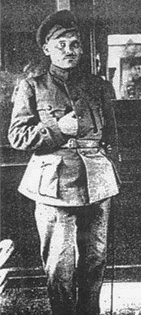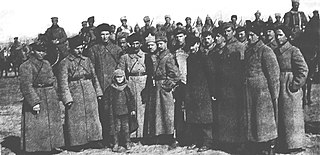
Nykyfor Oleksandrovych Hryhoriv was a Ukrainian military leader noted for repeatedly switching sides during the Ukrainian War of Independence and Soviet-Ukrainian war.

The 1st Cavalry Army was a prominent Red Army military formation. It was also known as "Budyonny's Cavalry Army" or simply as Konarmia.

Fedir Shchus, also Fyodor Shuss or Feodosiy Shchus, was a commander (ataman) in the Revolutionary Insurgent Army of Ukraine of Nestor Makhno.

Semen Mykytovych Karetnyk was a Ukrainian anarchist and a commander of the Revolutionary Insurgent Army of Ukraine (RIAU). He often replaced Nestor Makhno as supreme commander of the Insurgent Army in 1920. Karetnyk gained a reputation for his central role in defeating the White Army in Crimea in November 1920.

The Revolutionary Insurgent Army of Ukraine, also known as Makhnovtsi, named after their leader Nestor Makhno, was an anarchist army formed largely of Ukrainian peasants and workers during the Russian Civil War of 1917–1922. They protected the operation of "free soviets" and libertarian communes by the Makhnovshchina, an attempt to form a stateless anarcho-communist society from 1918 to 1921 during the Ukrainian War of Independence.
The Battle of Perehonivka or Battle of Peregonovka was a September 1919 military conflict in which the Revolutionary Insurgent Army of Ukraine defeated the Volunteer Army. After retreating west across Ukraine for four months and 600 kilometers, the Insurgent Army turned east and surprised the Volunteer Army. The Insurgent Army reclaimed its capital of Huliaipole within ten days.
The Katerynoslav March was a campaign to transfer the 8th Corps of the Armed Forces of the Ukrainian State from Katerynoslav to Crimea, in order to join the Volunteer Army of Anton Denikin.

The 1st Donetsk Corps was a military formation of the Revolutionary Insurgent Army of Ukraine, it was created on 1 September 1919 and existed until 1920.
The 7th Ukrainian Soviet Division was a military unit of the Red Army during the Russian Civil War in the armed forces of the Ukrainian SSR.
Oleksandr Kalashnykov was a Ukrainian anarchist and a commander of the 1st Donetsk Corps of the Revolutionary Insurgent Army of Ukraine.
Mikhail Uralov was a Russian anarchist, the head of the "Black Guard" combat units of the Moscow Federation of Anarchists ,and a commander of the Revolutionary Insurgent Army of Ukraine.
Hryhorii Ivanovych Makhno was a Ukrainian rebel commander and brother of Nestor Makhno.
Vasyl Mikhailovych Sharovsky was a member of the Central Council of Ukraine, an anarcho-communist and an artillery commander of the Revolutionary Insurgent Army of Ukraine.

Foma Kozhyn was a Ukrainian revolutionary and the commander of the machine-gun regiment of the Revolutionary Insurgent Army of Ukraine.

Hryhory Vasylivsky was a commander in the Revolutionary Insurgent Army of Ukraine, often serving as Nestor Makhno's aide-de-camp and as the army's chief of staff.

Vasyl Kurylenko was a commander in the Revolutionary Insurgent Army of Ukraine.

The Starobilsk agreement was a 1920 political and military alliance between the Makhnovshchina, an anarchist mass movement led by Nestor Makhno's Insurgent Army, and the Ukrainian Soviet Socialist Republic, which the Bolsheviks had established as the legitimate government of Ukraine.
The Bolshevik–Makhnovist conflict was a period of political and military conflict between the Ukrainian Soviet Socialist Republic and the Makhnovshchina, for control over southern Ukraine. The Bolsheviks aimed to eliminate the Makhnovshchina and neutralise its peasant base. In turn, the Makhnovists fought against the implementation of the Red Terror and the policy of war communism.
Mykhailo Brova was a Ukrainian anarchist military commander and member of the Makhnovist movement. He was a delegate to the Regional Congresses and member of each convocation of the Military Revolutionary Council.
Luka Nykyforovych Bondarets was the cavalry commander of the Revolutionary Insurgent Army of Ukraine (RIAU).









